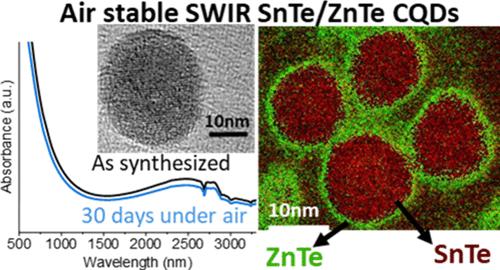空气稳定短波红外碲化锡和碲化锡/碲化锌核壳胶体量子点
IF 7
2区 材料科学
Q2 CHEMISTRY, PHYSICAL
引用次数: 0
摘要
迄今为止,在短波红外区域(SWIR, 1-2.6 μm)吸收的胶体量子点(CQDs)通常由有害的镉、铅或汞硫族化合物组成,这限制了商业接受度。因此,需要环境友好的替代品,以确保在制造、使用和处置过程中对生态系统的破坏最小。一种很有前途的不含有害元素的SWIR吸收纳米材料是硫化物锡。我们开发了碲化锡(SnTe) CQDs,其尺寸范围为~ 17至26 nm,相应的吸收峰范围为~ 2.3至2.5 μm,表明尺寸依赖于量子限制。采用空气稳定锡盐(氯化锡或醋酸锡)代替典型的空气敏感二(二(三甲基硅基)氨基锡(II)。通过优化配体类型(以1-十二硫醇代替油酸防止氧化)、注射方式、生长温度、反应时间、锡碲前驱体的投料摩尔比等因素对合成工艺进行了系统的研究。为了提高ZnTe在空气中的稳定性,在70℃下与乙酸锌进行阳离子交换反应,成功地合成了ZnTe壳。对SnTe/ZnTe核壳纳米晶体进行了全面表征,发现形成了2 - 3层单层的保护性ZnTe壳,在空气中具有长达1个月的长期稳定性。这些空气稳定的CQDs可能为低成本的溶液可加工制造SWIR光电子器件提供一种低毒性的替代纳米材料。本文章由计算机程序翻译,如有差异,请以英文原文为准。

Air-Stable Short-Wave Infrared Tin Telluride and Tin Telluride/Zinc Telluride Core–Shell Colloidal Quantum Dots
To date, colloidal quantum dots (CQDs) with absorption in the short-wave infrared region (SWIR, 1–2.6 μm) typically consist of hazardous cadmium, lead, or mercury chalcogenides, which limit commercial acceptance. Environmentally friendly alternatives are therefore required to ensure minimal damage to ecosystems during fabrication, use, and disposal. A promising hazardous-element-free SWIR absorbing nanomaterial candidate is tin chalcogenide. We have developed tin telluride (SnTe) CQDs, with a size ranging from ∼17 to 26 nm and corresponding absorption peak from ∼2.3 to 2.5 μm, indicative of size-dependent quantum confinement. Air-stable tin salts (tin chloride or tin acetate) were employed instead of the typical air-sensitive bis(bis(trimethylsilyl)amino tin(II). The synthesis was systematically investigated by optimizing the ligand type (1-dodecanethiol was used to replace oleic acid to prevent oxidation), injection method, growth temperature, reaction time, and feed molar ratio between tin and tellurium precursors. To improve stability in air, a ZnTe shell was successfully synthesized via cation exchange reaction at 70 °C with zinc acetate. The SnTe/ZnTe core–shell nanocrystals were fully characterized, revealing the formation of a protective ZnTe shell with a thickness of two to three monolayers, resulting in long-term stability in air (up to 1 month). These air-stable CQDs may offer a low-toxicity alternative nanomaterial for low-cost solution-processable fabrication of SWIR optoelectronics.
求助全文
通过发布文献求助,成功后即可免费获取论文全文。
去求助
来源期刊

Chemistry of Materials
工程技术-材料科学:综合
CiteScore
14.10
自引率
5.80%
发文量
929
审稿时长
1.5 months
期刊介绍:
The journal Chemistry of Materials focuses on publishing original research at the intersection of materials science and chemistry. The studies published in the journal involve chemistry as a prominent component and explore topics such as the design, synthesis, characterization, processing, understanding, and application of functional or potentially functional materials. The journal covers various areas of interest, including inorganic and organic solid-state chemistry, nanomaterials, biomaterials, thin films and polymers, and composite/hybrid materials. The journal particularly seeks papers that highlight the creation or development of innovative materials with novel optical, electrical, magnetic, catalytic, or mechanical properties. It is essential that manuscripts on these topics have a primary focus on the chemistry of materials and represent a significant advancement compared to prior research. Before external reviews are sought, submitted manuscripts undergo a review process by a minimum of two editors to ensure their appropriateness for the journal and the presence of sufficient evidence of a significant advance that will be of broad interest to the materials chemistry community.
 求助内容:
求助内容: 应助结果提醒方式:
应助结果提醒方式:


